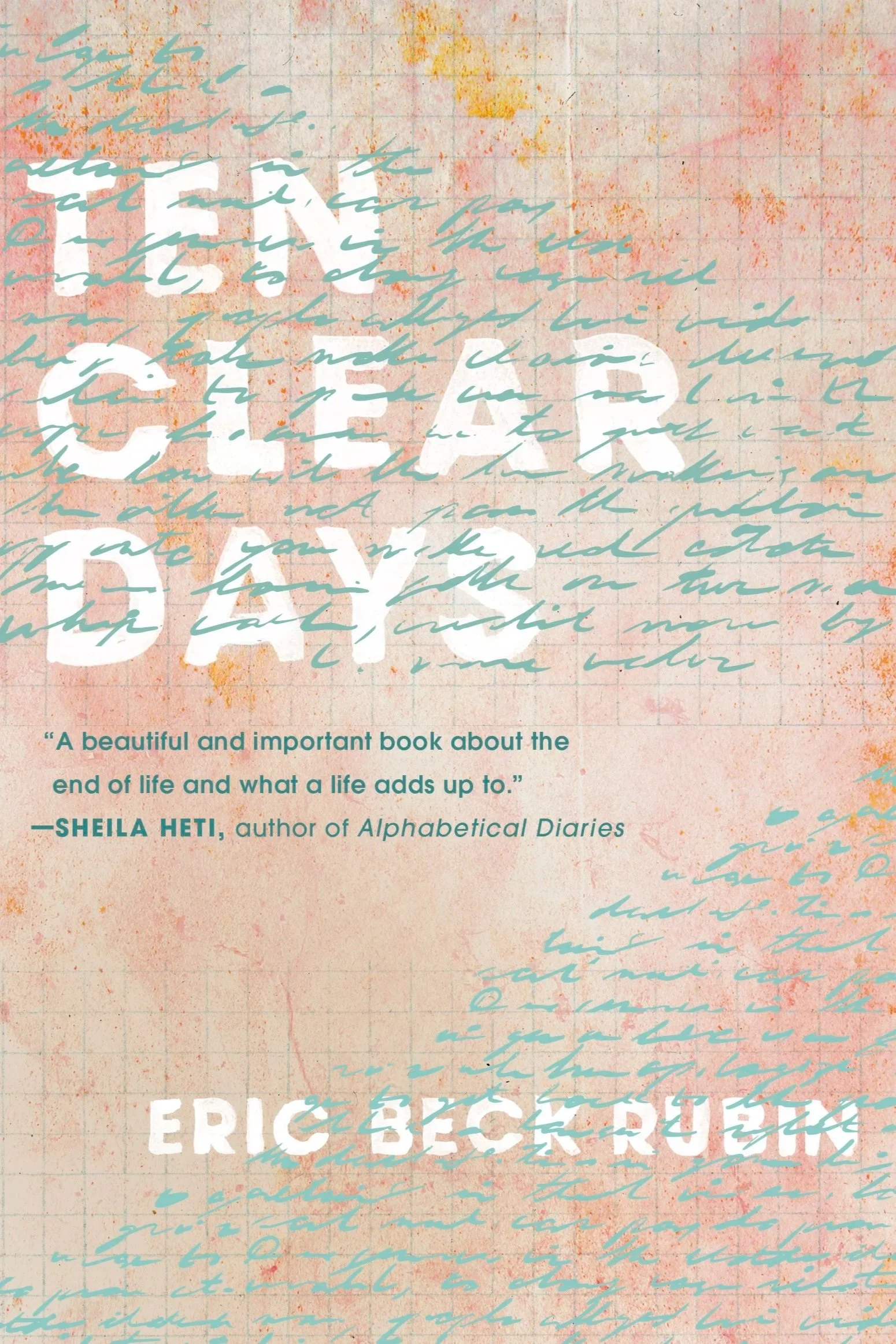“A story of a whole generation told through the life of one woman and her own way of being: her stubbornness, her independence, her gravity, her humor.”
S H E I L A H E T I
“Scrupulously observed and emotionally crushing, Ten Clear Days asks profound questions about what it means to let go of someone we love. Eric Beck Rubin wields language like a scalpel . . . You’ve never read anything quite like this before.”
A L I S O N P I C K
“Here, the body is an archive and a memorial, the caretaker an investigator. What a carefully constructed and gorgeous, urgent novel.”
J E N N I F E R G I L M O R E
–––
When a Holocaust survivor requests medical assistance in dying, it divides her family.
Over ten increasingly tense days, we come to know her story and its final outcome.
–––
Publication date: April 14, 2026
Order and pre-Order:
Barnes & Noble, Bookshop.org, Amazon, Indigo
Photograph ©: Nolan Begley
Eric Beck Rubin is a Novelist, Cultural Historian and Lecturer. As a Doctor of Literature and Master of Architectural History and Theory, Eric’s broad and varied expertise focus on the cultural artifacts – artistic, literary and architectural – of history, memory and trauma. He has taught internationally, including at the University of Toronto and Bergen Arkitektskole, and consulted for institutions such as the Art Gallery of Ontario and Facing History. His debut novel School of Velocity was named one of the Guardian’s Best Books of the Year, and his second novel Ten Clear Days will be published in April 2026. In addition to writing and teaching, Eric is currently heading a research team tracing the history of a post-impressionist portrait to verify its authenticity.
Selected Work:
School of Velocity
Pushkin Press / Doubleday Canada
‘A taut novel that builds tension to thriller level’ – Sian Cain, The Guardian
‘Gripping and emotional’ – David Nicholls, The Observer
‘A gut-punching confrontation’ – Publishers Weekly
‘A tragic meditation on the impossibility of reliving the past, however much we cling to our memories’ – Rebecca Liu, Financial Times
‘A fascinating dissection of the power of friendship’ – Sue Leonard, Irish Examiner
‘About deciding, or even knowing, what the people we desire most really mean to us’ – André Van Loon, Los Angeles Review of Books
‘A beautifully written debut novel about obsession and repression’ – Attitude
‘Engrossing and unsettling’ – International Piano
Guardian Review
Guardian Author profile
Guardian/Observer Best Books 2016
Memory Unearthed
Art Gallery of Ontario, MFA Boston / Yale University Press
From 1941 to 1944 the Polish Jewish photographer Henryk Ross (1910–91), a prisoner in the Lodz Ghetto, was forced to create propaganda about the ghetto’s implementation of work policies, part of a so-called work-to-survive program. Covertly, Ross used his camera to capture scores of daily, intimate moments of Jewish life and death among the ghetto’s 160,000 Jewish prisoners. In 1944, Ross buried thousands of negatives in an attempt to save his secret record. After the war, he returned to Lodz to retrieve them. Although many were degraded and destroyed in their hiding places, nearly 3,000 negatives survived.
In 2015, The Art Gallery of Ontario mounted the first complete exhibition of Ross’ photographs, which then travelled to the Museum of Fine Arts in Boston.
Eric was one of the exhibit’s four adjunct curators, a speaker at all the Gallery’s special events surrounding the exhibit, and he wrote an essay on Ross’ photographs, ‘The Ordinary and the Extreme’, for the catalogue.
Boston Globe
Wall Street Journal
Tablet Magazine
Art Research
2019 - present
Since 2019, Eric has been engaged in guiding a post-Impressionist painting through the stages of authentication – scientific testing, provenance research and expert acceptance. This culminated in the panting’s exhibition in a major retrospective of the artist’s work at the Albertina Museum, Vienna, and its inclusion in a forthcoming, highly-anticipated catalogue raisonné of the artist, which will be published by Yale University Press.
Investigation into the history and sale of the painting led Eric to a series of questions regarding changes in art market practices specifically due to the authentication of this artist’s work. He is currently looking for a research and writing partner to further this inquiry.
Consulting and Competitions
2015 - present
A specialist on the memorialisation of trauma in art and architecture, Eric has been included as the architectural historian on a number of North American memorial and museum design competitions.
His language skills (French and German) have also carried him into the fields of art research and restitution.
Selected Consultations and Collaborations:
Affleck de la Riva and Schwartz Silver Architects
Mondex Corp
Anna Passakas and Radek Kudlinski
Samples of writing on Art, Architecture, Literature and Memory in popular and peer-reviewed journals:
Georges Perec and Horreur Vacui, Los Angeles Review of Books
Imre Kertész, Nietzsche and Sisyphus, Comparative Literature and Culture
Memoirs of an Indirect Witness to Trauma, Journal of Modern Literature
Reconstruction of Dresden, Descant
Daniel Libeskind’s Memorials, Berfrois
Essays and Criticism
Teaching
2004 – Present
Currently teaching Architecture and Literature at the University of Toronto and University of Waterloo, Eric’s courses combine his disparate areas of specialty – Memorials and Memory, 19th and 20th Century Literature, Fin–de–Siècle Vienna, and South Asian and Post–Colonial Studies. The common interest is in the way works of art transmit memory, and what happens when we use fiction as a means of conveying history.
Highlights:
Forgetting Architecture – Memorial and Monument Design
The Impossible Necessity – Libraries and the Limits of Knowledge
Iconography of Modernism – Architecture through the 20th Century
Eric has spoken publicly or been interviewed on a variety of themes in the literary, fine art, architecture and historical spheres for organisations such as the BBC, International Festival of Authors, Facing History, Art Gallery of Ontario and the CBC. He has also conducted numerous public interviews of notable authors and translators including Sheila Heti, Etgar Keret and Alison Pick.



